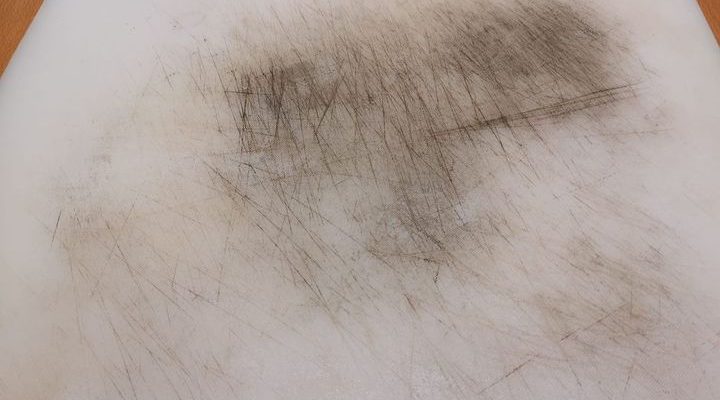

How I Tested the Different Methods
I created a swift paste by combining turmeric and water, which I then spread across five distinct cutting boards. Having previously used this concoction as a natural fabric dye, I was aware of how easily the vivid color could stain any surface it touched. This experiment served as my control for each cutting board.
The ratings: Each approach was rated on a scale of one to five, with five representing the most effective approach and one representing the least preferred approach. In addition to the rating, I have included some comments on the level of ease or difficulty of the approach, the amount of effort required, and the time it took to complete.

Cutting Board Cleaning Method: Baking powder and white vinegar
- Total time: 10 minutes
- Rating: 1/5
The method: Combine baking powder and white vinegar in equal amounts to create a paste. Apply the paste onto the stain and allow it to sit for a minimum of 5 minutes. Proceed to rinse with water using a soapy sponge.
Here’s what happened: I was curious to understand the reasons for using baking powder instead of baking soda for cleaning, and I was astonished to discover that baking powder is essentially baking soda combined with an acidic component. I have utilized the reliable baking soda and vinegar combination to clean numerous items, so I had optimistic expectations, but unfortunately, this approach did not yield any positive outcomes.

Cutting Board Cleaning Method: Essential oil, vinegar, and water
- Total time: 5 minutes
- Rating: 2/5
The method: Mix 1 cup of water, 1/2 cup of distilled white vinegar, and 5 to 8 drops of high-quality essential oil (such as Thieves oil) in a spray bottle. Shake well, spray the mixture onto the entire board, and scrub using a stiff-bristle brush. Rinse thoroughly with dish detergent to clean.
How it went: It took me longer to mix all the ingredients together than it did to realize that this method was not going to be successful. Once I sprayed the entire surface, I used a stiff-bristle brush to work the mixture around, but there was no noticeable effect. Adding dish soap caused the soap bubbles to turn yellow due to turmeric particles. While this mixture is a good disinfectant alternative to bleach, it is not effective in removing stubborn stains.

Cutting Board Cleaning Method: Lemon and sunshine
- Total time: One day
- Rating: 3/5
The method: Slice a lemon in half, extract the juice while rubbing it onto the stained cutting board. Afterwards, place the board outdoors and allow it to bask in the sunlight for the duration of the day.
How it went: The blemish lightened slightly, yet remained quite noticeable. It is conceivable that by repeating this procedure and allowing the cutting board to sit in the sun for several days, you would achieve significantly improved outcomes as the sun serves as an effective bleaching agent. I do not suggest this approach for promptly eliminating stains from your cutting board, but it is an excellent method to employ if you have the time and prefer not to exert much effort.

Cutting Board Cleaning Method: Hydrogen peroxide, baking soda, and dish soap
- Total time: Overnight
- Rating: 4.5/5
The method: Combine 3 to 4 tablespoons of baking soda, 1 tablespoon of dish soap (such as Dawn), and 1 to 2 tablespoons of hydrogen peroxide in a small bowl. Apply the mixture onto the stain and allow it to rest overnight. Rinse thoroughly and scrub using warm, soapy water.
How it went: The next method I tried was using a mixture of baking soda and vinegar. I let it sit for a few hours, and when I wiped it away, I was amazed to see that the stain had almost disappeared completely. I followed up with a bit of dish soap, and the remaining bit of the stain vanished. I was truly impressed with the effectiveness of this method. I would definitely recommend it as a top contender for stubborn stains.

Cutting Board Cleaning Method: Baking soda, salt, vinegar, and hydrogen peroxide
- Total time: 10 minutes
- Rating: 4.5/5
The method: Kitchn provides a reliable technique that involves two distinct steps that are flexible to be carried out at any time. Initially, immerse the board in a solution of white vinegar or apply a 3% hydrogen peroxide solution. (In either case, allow the board to rest for a minimum of five minutes before cleaning it once more with soap and water.) Subsequently, create a mixture consisting of equal parts baking soda, salt, and water to eliminate surface stains.

How it went: This recipe requires several ingredients, but they are all common items that most people already have at home. I appreciated the two-step process because it allows you to choose whether to soak the board or not, depending on the level of staining. The scrub mixture has the ideal consistency: thin enough to spread evenly on the cutting board, but not too watery. When using baking soda on stains, I usually anticipate some scrubbing, but the results are worth it as the stains vanish. I’m pleased to say that this method required less effort than I initially thought.

How do you clean your plastic cutting boards when they’re extra stained?


